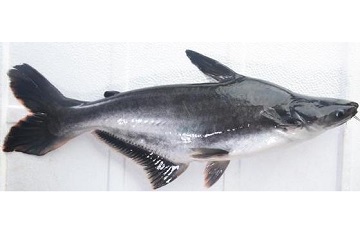IPB Researchers Mature Gonad of Siamese Catfish with Javanese Long Pepper

To increase the availability of large amounts of catfish seed, it is necessary to rise the population of ready-to-use parent stock for hatcheries. However, the maturation of the catfish gonad is relatively slow. Male brood stock commonly used in spawning is two years old weighing 1.5-2 kilograms. The maturation of fish gonads involves hormonal mechanisms influenced by stimuli from environmental signals, such as temperature, season, light intensity and tides.
The steroid hormone commonly used is a synthetic hormone that requires a high cost and is not environmentally friendly as it leaves residues in the water and at the bottom of the pond. The alternative ingredient as a boost to the maturation of male gonads is phytosteroid which can be collected from plants. Example of phytosteroid to spur gonad maturation is Piper retrofractum Vahl (Javanese long pepper).
Four researchers consisting of Muhammad Zairin Jr., Dinar Tri Soelistyowati and Widanarni from the Department of Aquaculture, Faculty of Fisheries and Marine Sciences (FPIK) of Bogor Agricultural University (IPB) along with Yeni Elisdiana from the Study Program of Aquaculture, Graduate School of IPB, conducted a research on the maturation of Siamese catfish gonad with the provision of Javanese long pepper extract (Piper retrofractum Vahl).
"Javanese long pepper is one of the plants having a stimulant effect on nerve cells and hormonal effect. This study aimed to evaluate the provision of Javanese long pepper extract (ECJ) through feeding to gonad maturation of male Siamese catfish," said Zairin.
In the experiments, the researchers used ten eight-months-old male catfishes in each repetition. The treatment provided by this research included negative control (A); extract of Javanese long pepper (ECJ) with 37.5 mg/kg dose of fish/day (B); and 187.5 mg/kg dose of fish/day (C); as well as 17-α methyltestosterone with 50 μg/kg dose of fish/week as positive control (D). Treatment was given through commercial feed for eight weeks.
From this experiment, the ECJ treatment showed that a gonad maturity index (IKG) was higher than control since the 2nd week. Blood testosterone levels in ECJ treatment were 187.5 mg/kg of fish/day higher than control. At the 8th week, the distribution of spermatozoa in ECJ treatment reached 75 percent, while the control spermatozoa distribution was less than 50 percent. The density, volume, and motility of sperm treated by ECJ and 17α-methyltestosterone were also higher than control treatment at the 8th week, but the spermatocrit levels showed similar results.
The researchers explained that the concentration of testosterone in fish blood has consistent values with IKG. "The more increase the IKG fish, the concentration of testosterone also increases. This is due to the fact that testosterone is a major hormone influencing the development of male gonads (spermatogenesis). The concentration of testosterone of fish blood treated with Javanese long pepper extract was higher when compared to negative control," he said.
The team concluded that Javanese long pepper extract (ECJ) had a significant effect on gonad maturation of male catfish. The ECJ dose of 187.5 mg/kg of fish/day showed higher IKG values, testosterone and sperm quality than other treatments. "ECJ treatment of 187.5 mg/kg of fish/day given through feeding for 8 weeks resulted in IKG of 5.40 percent, spermatozoa distribution reached 75 percent, and testosterone levels of 9.54 mg/ml," he said. (TK)



